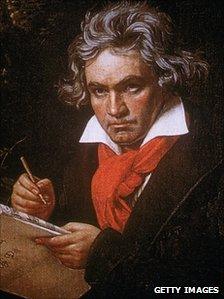'Lost' Beethoven work to be aired
- Published

Beethoven wrote a total of 16 string quartets
A "lost" Beethoven movement is to be performed for the first time in more than 200 years, after being pieced together from early drafts.
Beethoven wrote the slow movement for his string quartet Opus 18 Number Two in 1799 before discarding it and composing another version a year later.
The original has not survived, but has now been reconstructed by Prof Barry Cooper of Manchester University.
He has reassembled the surviving sketches, filling in any gaps himself.
Prof Cooper, one of the world's leading experts on the composer, said preliminary sketches from Beethoven's notebooks had survived for all 74 bars of the movement.
But half of the bars were written for just one instrument, meaning Prof Cooper has completed the missing instrument parts himself.
"You've got a pretty good idea of what the music is like," he told 成人快手 News.
"The movement will certainly be strikingly similar to what Beethoven wrote. Obviously it can't possibly be exactly the same."
Prof Barry Cooper of Manchester University explains how he reassembled Beethoven's original version
The original movement was delivered to Beethoven's patron Prince Franz Joseph Maximilian von Lobkowitz in 1799 before being replaced with a revised version.
'A perfectionist'
The full manuscript of the original composition has not been seen since. But Beethoven wrote to a friend in 1801, telling him that he had not mastered the composition of quartets at the time that he wrote the original.
"He was a perfectionist," Prof Cooper said. "He felt that when he wrote this early movement, he didn't actually know how to write quartets. Any other composer would have been delighted to have written this lovely movement."
The completed movement will be performed by the university's resident string quartet Quatuor Danel at the Martin Harris Centre in Manchester on Thursday.
The performance comes 13 years after Prof Cooper stirred controversy in the classical music world by creating a 10th Symphony based on unfinished Beethoven sketches.
He said there was "far more" evidence for the contents of the string quartet than for the symphony, meaning it was "much easier to piece together".